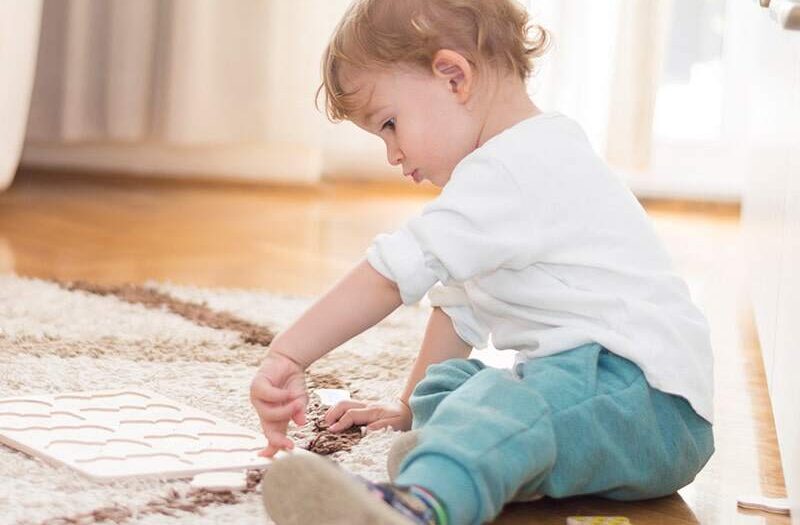Life with a 15-month-old is full of energy and excitement. Here are some tips for navigating this whirlwind stage:
- Give Attention and Praise: Your toddler craves your attention, so make sure to lavish it on them when they do something you like. Positive reinforcement encourages good behavior and strengthens your bond.
- Avoid Power Struggles: Pick your battles and sidestep power struggles when possible. Save your energy for addressing more significant issues, such as hitting or biting, with firm but gentle discipline.
- Encourage Imitation and Pretend Play: Toddlers love to copy adult activities and play with “real” objects. Encourage their imagination and creativity by engaging in pretend play together. Provide props like plastic keys or a toy phone to spark their imagination.
- Be Patient and Flexible: Understand that your toddler is still learning and exploring the world around them. Be patient with their curiosity and energy, and be flexible in adapting to their needs and interests.
By embracing the whirlwind nature of life with a 15-month-old and providing love, guidance, and encouragement, you can help your toddler thrive during this exciting stage of development.
Embracing Your Toddler’s Progress
At 15 months, your toddler is making significant strides in physical development. Here are some key points to consider during this milestone period:
- Walking Milestone: By now, most toddlers are walking confidently, marking a significant transition from babyhood to toddlerhood. Encourage your toddler to take bigger steps and explore their newfound mobility.
- Curiosity and Exploration: Your toddler’s curiosity knows no bounds, and they’re eager to explore their environment in new ways. Understand that their desire to pull objects off shelves and walk around with them is a natural part of their development.
- Encouraging Movement: If your toddler is still gaining confidence in walking, provide support and encouragement. Consider using a walker toy to help them build confidence in their ability to move independently.
- Safe and Fun Activities: Plan outings and activities that promote safe and enjoyable movement. For example, play with a large, lightweight ball in a grassy area with a gentle slope, allowing your toddler to chase after it and develop coordination skills.
- Patience and Support: Be patient and supportive as your toddler navigates these new physical challenges. Celebrate their achievements and provide gentle guidance as they explore their capabilities.
By embracing your toddler’s progress in physical development and providing opportunities for safe exploration and movement, you can support their growth and development during this exciting stage.
Encouraging Language and Cognitive Development
Exploring Books Together
At around 15 months, many toddlers start showing an interest in books. Whether they’re flipping through pages or gnawing on them, this is a crucial time to introduce the joy of reading. Here’s how you can foster a love for books:
- Persistence Pays Off: If your toddler seems too wiggly for a reading session, don’t give up. Keep introducing books, and eventually, they’ll develop a fondness for sitting and listening to stories.
- Choose Age-Appropriate Books: Opt for board books with sturdy pages and colorful, engaging illustrations. Look for books with textures or interactive elements to capture your child’s interest.
- Interactive Reading: Encourage participation by asking simple questions as you read, such as “Where is the dog?” or “What does the cow say?” Let your child pat the pictures and turn the pages themselves.
- Variety is Key: If your child loses interest in one book, try switching to another with catchy rhymes or familiar characters. Keep the reading experience fresh and exciting.
- Reading Anywhere, Anytime: Your child doesn’t have to be sitting still for a story. You can read to them while they’re playing on the floor or even during bedtime cuddles.
- Embrace Repetition: Toddlers often enjoy hearing the same story repeatedly. Repetition helps them learn new words and reinforces familiar concepts, providing comfort and familiarity.
Nurturing Early Speech
If you’re concerned about your child’s speech development, remember that every child progresses at their own pace. Here are some tips to support their language skills:
- Keep Talking: Engage in conversations with your child throughout the day, even if they’re not speaking much yet. Encourage them to communicate by listening attentively and responding to their attempts at speech.
- Encourage Listening: Pay attention to your child’s ability to hear and respond to sounds. Poor hearing can contribute to speech delays, so consult with their doctor if you have any concerns.
- Reading Together: Reading aloud to your child is one of the best ways to promote language development. Spend time exploring books together, pointing out objects, and describing the pictures.
- Avoid Baby Talk: Use clear, simple language when speaking to your child, and model correct pronunciation. Avoid using baby talk excessively, as it can be confusing for young learners.
- Be Patient and Supportive: Celebrate your child’s attempts at speech, even if their words aren’t always clear. Encourage their efforts and provide plenty of opportunities for them to practice and learn.
By nurturing your child’s love for books and providing support as they navigate early speech development, you’re laying the groundwork for a lifetime of learning and communication.
Addressing Behavioral Health and Development
Handling Hard Goodbyes
Separation anxiety can be tough for both parents and toddlers. Here are some strategies to make saying goodbye a little easier:
- Say Goodbye: Always say goodbye to your child when you leave, even if it seems easier to sneak away. This helps build trust and reassures your child that you’ll return.
- Keep it Matter-of-Fact: Try to make goodbyes brief and calm, even if your child is upset. Remaining composed can help them feel more secure.
Dealing with Biting
Biting is a common behavior in toddlers, often stemming from frustration or a lack of communication skills. Here’s how you can address it:
- Stay Calm: React calmly if your child bites someone. Attend to the child who was bitten first, and then redirect the biter while acknowledging that biting is not acceptable.
- Identify Triggers: Pay attention to what triggers biting episodes, such as feeling threatened or tiredness. Addressing these triggers can help prevent future incidents.
- Avoid Punishment: Avoid yelling or punishing the child for biting. Instead, focus on teaching them appropriate ways to express themselves and manage their emotions.
Seeking Attention
At 15 months, toddlers crave attention and may resort to various behaviors to get it. Here’s how you can manage:
- Stay Connected: Engage with your child and provide attention when possible. Respond to their attempts at communication and acknowledge their feelings.
- Set Limits: Establish clear boundaries and enforce them consistently. This helps your child understand acceptable behavior and reduces attention-seeking actions.
- Practice Patience: Understand that seeking attention is a normal part of development. Stay patient and supportive, even during challenging moments.
Power Struggles and Meltdowns
As toddlers assert their independence, power struggles and meltdowns may occur. Here’s how to navigate these challenges:
- Choose Battles Wisely: Avoid unnecessary power struggles and focus on important issues. Offer choices when possible to give your child a sense of control.
- Stay Calm During Meltdowns: Remain calm and supportive during tantrums. Offer comfort and reassurance while setting clear limits on behavior.
- Establish Routines: Create predictable routines for daily activities like bedtime and mealtime. Consistency helps reduce stress and promotes cooperation.
- Take Care of Yourself: Parenting can be demanding, so prioritize self-care to manage stress and maintain patience during challenging moments.
By implementing these strategies, you can support your child’s behavioral health and development while navigating the ups and downs of toddlerhood.
Encouraging Social Development in Toddlers
Engaging in Imaginary Play
Encouraging pretend play is vital for your toddler’s development. Here’s how you can facilitate imaginative play safely:
- Provide Safe Props: Offer safe objects that mimic real-life items, such as plastic keys or an old purse with harmless contents. This allows your child to mimic adult behaviors without risk.
- Create Play Spaces: Designate a childproof area where your toddler can freely explore and play without constant redirection or “no”s. This provides a safe environment for imaginative play.
- Role Play Together: Engage in role-playing activities with your child to stimulate their imagination. Encourage creativity by pretending to be different characters or animals together.
Understanding Imaginary Play
At 15 months, toddlers are beginning to engage in imaginative play, mimicking real-life actions and behaviors. Here’s what to expect:
- Symbolic Play: Your child may use everyday objects to represent other items or actions, such as pretending a spoon is a shovel or a phone.
- Copying Adult Behavior: Toddlers often imitate adults, mimicking activities like cooking, cleaning, or caring for dolls or stuffed animals.
- Role Reversal: Role-playing allows your child to experiment with different roles and scenarios, boosting confidence and social skills.
Handling Shyness and Social Situations
If your toddler displays shyness or reluctance in social situations, here’s how you can support them:
- Avoid Labels: Refrain from labeling your child as “shy.” Instead, provide reassurance and understanding in new or overwhelming social settings.
- Provide Comfort: Offer gentle encouragement and support during social interactions. Allow your child time to warm up without pressure.
- Praise Efforts: Acknowledge and praise your child’s sociable moments rather than focusing on times when they are reserved. This reinforces positive social behaviors.
By fostering imaginative play, creating safe play spaces, and providing support in social situations, you can nurture your toddler’s social development and confidence.
Exploring Playgroups for Social Development
Benefits of Mixed-Age Playgroups
Consider joining a playgroup that includes children of various ages, including slightly older ones. Here’s why:
- Leadership Opportunities: Older children often take on leadership roles in play, engaging younger ones and fostering cooperation and social interaction.
- Learning from Peers: Younger children learn from older peers, observing and imitating their behaviors, language, and play activities.
- Cooperative Play: Mixed-age groups encourage cooperation and collaboration among children of different developmental stages, promoting social skills and empathy.
Tailoring Playgroups to Your Child’s Needs
If your child is hesitant about separation or prefers smaller groups, consider these options:
- Small Group Dynamics: Start with a small playgroup of two or three children who are the same age as your toddler. This provides a comfortable environment for social interaction and reduces separation anxiety.
- Gradual Adjustment: Once your child becomes familiar with playing with peers of similar age, gradually introduce them to larger or mixed-age playgroups.
- Parental Involvement: Stay involved in the playgroup activities initially to provide reassurance and support for your child as they transition into social settings.
By participating in playgroups tailored to your child’s needs and preferences, you can support their social development while providing opportunities for interaction, cooperation, and learning from peers of varying ages.
Addressing Nightmares in Toddlers
Understanding Toddler Nightmares
As toddlers delve into imaginative play, they may experience nightmares, often without the ability to articulate their feelings. Here’s how you can identify and address these nighttime disturbances:
- Symbolic Thinking: At around 15 months, toddlers start to think symbolically, blurring the lines between reality and fantasy. Nightmares can stem from this newfound cognitive ability.
- Unusual Behaviors: Look for signs of distress during sleep, such as crying, restlessness, or sudden awakenings, which may indicate a nightmare.
- Potential Causes: Nightmares can occur due to stress or anxiety, whether related to family tension, changes in daycare or preschool, or for no apparent reason.
Comforting Strategies
When your toddler wakes up upset from a nightmare, try these comforting techniques:
- Soothing Voice: Speak to your child in a calm and reassuring tone, providing comfort and security during moments of distress.
- Physical Comfort: Offer gentle back rubs or cuddles to help soothe your child back to sleep, reassuring them that they’re safe.
- Establishing Routines: Consider implementing a bedtime routine that includes calming activities like reading stories about dreams and sleep. This can help alleviate fears and promote a sense of security.
Long-Term Support
While nightmares are common in toddlers, providing ongoing support and reassurance can help ease their fears over time:
- Open Communication: Encourage your child to express any fears or concerns they may have, even if they can’t verbalize them fully. Create a supportive environment where they feel safe sharing their feelings.
- Consistent Bedtime Routine: Maintain a consistent bedtime routine that fosters feelings of security and comfort, helping to minimize nighttime anxieties.
- Professional Guidance: If nightmares persist or seem to be related to underlying stressors, consider seeking guidance from a pediatrician or child psychologist for additional support and strategies.
By addressing nightmares with patience, understanding, and consistent support, you can help your toddler navigate through these nighttime fears and promote peaceful sleep patterns.



